
The Cucurbitaceae, also called cucurbits or the gourd family, are a plant family consisting of about 965 species in around 95 genera. Those most important to humans are the following:

Gourds include the fruits of some flowering plant species in the family Cucurbitaceae, particularly Cucurbita and Lagenaria. The term refers to a number of species and subspecies, many with hard shells, and some without. One of the earliest domesticated types of plants, subspecies of the bottle gourd, Lagenaria siceraria, have been discovered in archaeological sites dating from as early as 13,000 BCE. Gourds have had numerous uses throughout history, including as tools, musical instruments, objects of art, film, and food.
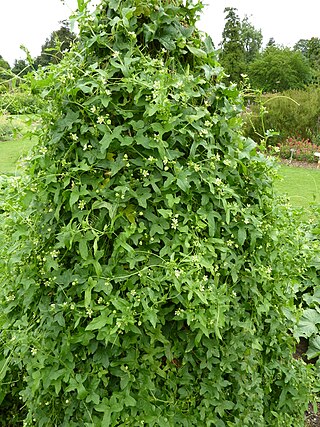
Bryonia is a genus of flowering plants in the gourd family. Bryony is its best-known common name. They are native to western Eurasia and adjacent regions, such as North Africa, the Canary Islands and South Asia.

Cucumis is a genus of twining, tendril-bearing plants in the family Cucurbitaceae which includes the cucumber, muskmelons, the horned melon, and the West Indian gherkin.

Pogostemon is a large genus from the family Lamiaceae, first described as a genus in 1815. It is native to warmer parts of Asia, Africa, and Australia.

Trichosanthes cucumerina is a tropical or subtropical vine. Its variety T. cucumerina var. anguina raised for its strikingly long fruit. In Asia, it is eaten immature as a vegetable much like the summer squash and in Africa, the reddish pulp of mature snake gourd is used as an economical substitute for tomato. Common names for the cultivated variety include snake gourd, serpent gourd, chichindapadwal and Snake Tomato.

Litsea is a genus of evergreen or deciduous trees or shrubs belonging to the laurel family, Lauraceae. The genus includes a large number of accepted species in tropical and subtropical areas of North America and Asia.
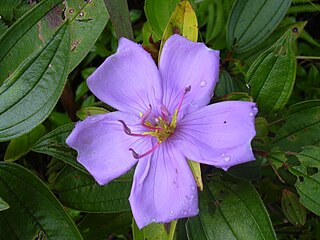
Melastoma is a genus in the family Melastomataceae. It has over 100 species distributed around Southeast Asia, India, north to Japan, south to Australia and the Pacific Islands. The number of species should probably be reduced according to some sources. Many species have been planted around the world for the aesthetic value of their bright purple flowers.

Melodinus is a genus of plant in the family Apocynaceae, first described as a genus in 1776. It is native to Indomalaya, Meganesia and various islands in the western Pacific. A type of monoterpenoid indole alkaloids called melodinines can be isolated from Melodinus plants.

Randia, commonly known as indigoberry, is a mostly Neotropical genus of shrubs or small trees in the Rubiaceae. As of February 2022 Plants of the World Online lists a total of 112 accepted species in the genus. Several Australian species have been reassigned to the genus Atractocarpus. These include the garden plants Atractocarpus chartaceus and A. fitzalanii.

Trichosanthes kirilowii is a flowering plant in the family Cucurbitaceae found particularly in Henan, Shandong, Hebei, Shanxi, and Shaanxi (China). It is one of the 50 fundamental herbs used in traditional Chinese medicine, where it shares the name guālóu with the related T. rosthornii. It is known as "Chinese cucumber" and "Chinese snake gourd" in English.

Cucurbitacins are a class of biochemical compounds that some plants – notably members of the pumpkin and gourd family, Cucurbitaceae – produce and which function as a defense against herbivores. Cucurbitacins and their derivatives have also been found in many other plant families, in some mushrooms and even in some marine mollusks.

Zehneria is a genus of flowering plants – of vines in the cucumber and gourd family, Cucurbitaceae. It contains about 35 species ranging from Africa, through Southeast Asia to Australia and Oceania. The name honours botanical artist Joseph Zehner.
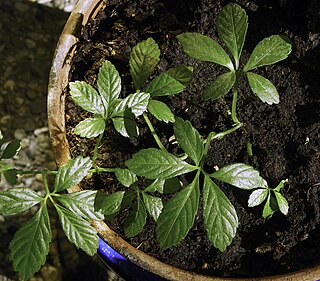
Gynostemma is a genus of perennial climbing vines in the cucumber, gourd, and melon family, comprising at least 19 species, all native to the tropical East or Far East, inclusive of the Himalayas: China ; the islands of Japan; Malaysia; and New Guinea. The term Gynostemma is derived from Ancient Greek γυνή meaning "woman" or "female", and στέμμα meaning "wreath" or "garland". In (post-)classical Latin the form stemma is attested as Greek loanword. In Ancient Greek and Latin, stemma is of neuter gender. German-Dutch botanist Carl Ludwig Blume described Gynostemma from two species he named: G. pedata and G. simplicifolia. Neither species was clearly designated by him as the type; however, the former species, G. pedatum is now considered to be a synonym of G. pentaphyllum(Thunb.) Makino. The genus was published in 1825, in Carl Ludwig von Blume's Bijdragen tot de flora van Nederlandsch Indië.
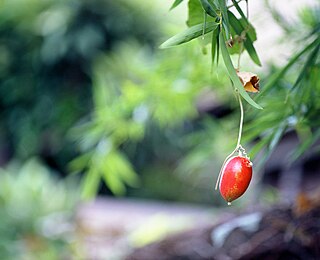
Trichosanthes pilosa is a tropical or semitropical vine bearing an edible fruit. It is native to Japan, Taiwan, India, Malaysia, Vietnam, the Philippines, China and other parts of southeast Asia as well as in Australia. It is known in English as Japanese snake gourd.
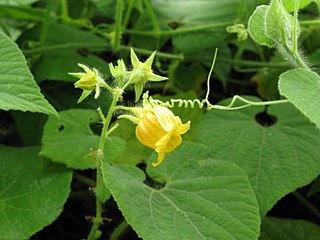
Thladiantha is a genus of flowering plants in the family Cucurbitaceae, native to the Indian subcontinent, Southeast Asia, and China. They are dioecious, perennial herbs. The best known species is Thladiantha dubia.

Echinopepon is a genus of flowering plants in the family Cucurbitaceae, native to the southwestern United States, Mexico, Central America, and South America. Tendrillate vines, their prickly fruits are operculate, with the prickles themselves being stipitate glandular.
Hemsleya is a genus of flowering plants belonging to the family Cucurbitaceae.
Solena is a genus of flowering plants belonging to the family Cucurbitaceae.


















